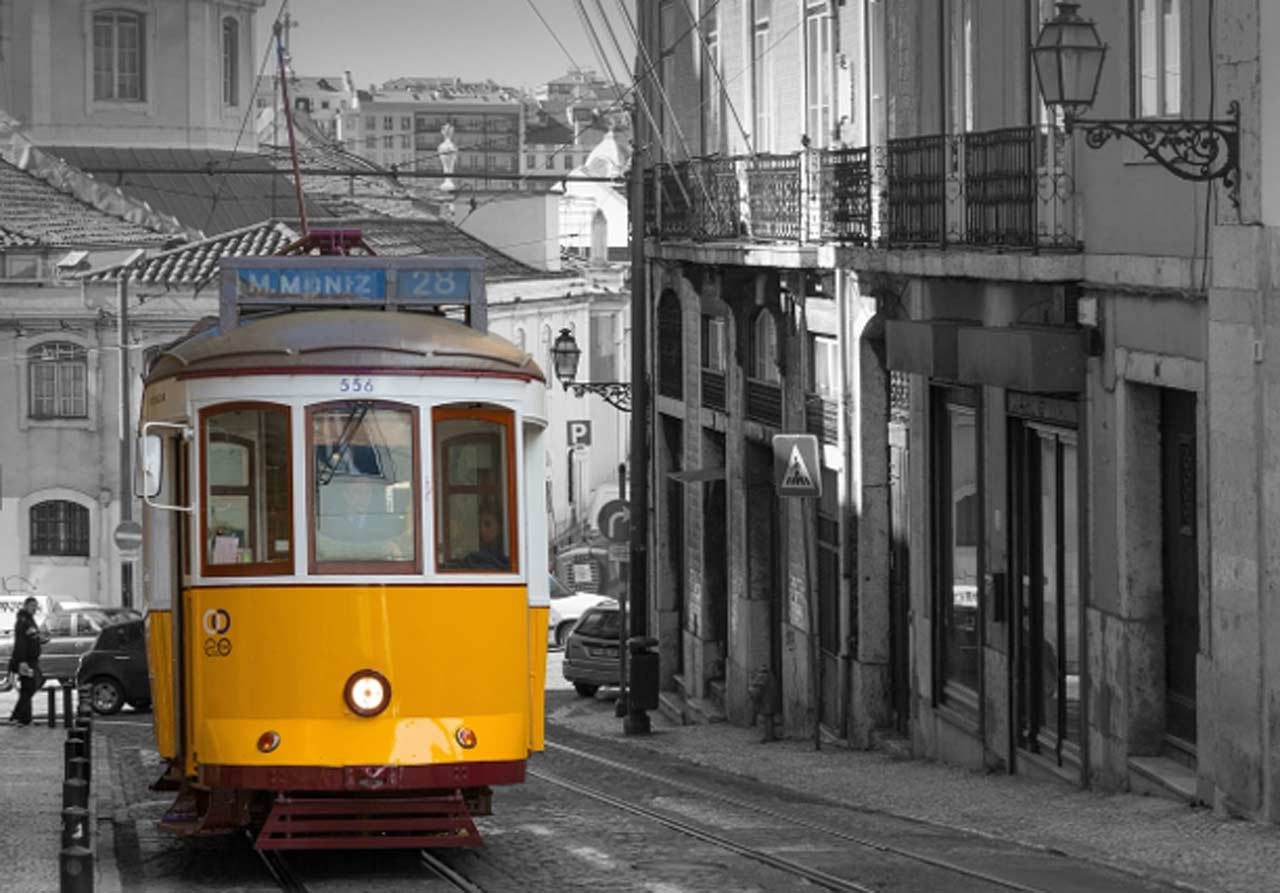Lisbon, one of Europe’s sunniest capitals, makes an excellent walking tour destination. Discover its UNESCO World Heritage Site districts such as Alfama, Bairro Alto and Chiado on an interesting walking tour through this sunny city.
Lisbon boasts an efficient public transport network consisting of metro, bus, tram, and funicular services. To make navigating around town simpler, download apps such as CityMapper or Gira with bike maps for Lisbon for an easier journey.
Buses
As is true of many European cities, public transport in Lisbon is the easiest and fastest way to navigate it. Carris, the city’s primary operator, covers most neighborhoods and many key attractions across its routes; compactness makes this even faster than driving; for group travel buying a Navegante Card will save time on fare calculations!
As you make your way through the city streets, keep an eye out for any suspicious behavior from pickpockets; pickpocketing is common on popular tram lines like 28.
Trams may be charming, but they may not be the most practical means of transportation in Lisbon. According to this link – leiebilguiden.no/portugal/lisboa/, traffic jams, double parking and the Portuguese propensity to speed through red lights all add up to an exhausting ride. Also, its narrow sidewalks and tight turns present additional obstacles for those with reduced mobility.
Buses offer more reliable transportation, with 24-hour services running reliably throughout the day and night. Apps make finding stops easier, while most locations also feature maps and timetables posted. No matter if it’s your first ride or your twentieth, the best practice for bus riding is always standing alongside it and waving to indicate your intention to board.
Buses in Seoul are yellow and marked with their line numbers on both their fronts and windshields, and ticket machines on board accept both credit cards and Zapping apps, which allow riders to pay by linking their credit cards and saving balances for later payments.
Trams
Lisbon’s trams are the highlight of many city tours for many tourists, especially Tram 28 which gets most of the fame among them all. But there are other routes worth discovering as well – Route 28 starts from Praca Martim Moniz to Campo de Ourique stopping at many key locations between them while connecting to other tram lines and Metro service so it’s easy to plan your day on foot!
The line is served by modern electric articulado trams that do not resemble the classic yellow carriages that many visitors expect of European city trams yet are perfectly serviceable and reliable ways to explore historic districts in Buenos Aires. Riding one can either be charming or nerve-wracking depending on whether or not there is space available; more crowded trams also become hotspots for pickpockets, so it is wise to keep a careful watch on all belongings at all times!
Route 24 is another notable tram route that’s well worth seeing, stretching from Ajuda National Palace to Prazeres Cemetery near Ajuda Botanical Garden and serviced by modern electric articulated trams. Along its path are stops like Jardim da Estrela, Basilica Estrella and Ajuda Botanical Garden – each stop on this journey provides unique experiences!
Both tram lines can also be purchased as 24-Hour tickets designed specifically for avid travelers, which include unlimited rides across the entire transport network without individual fare calculations. You may also wish to utilize the city’s Zapping system, a convenient pay-as-you-go option which makes switching modes of transport seamless; residual amounts will remain post ride; thus, it would be wiser to invest in a Navegante Card to ease usage and make life simpler!
Ferries
Ferries provide an exciting alternative to public transit options in Lisbon. Their routes to Belem show off Lisbon’s hilly topography while those to Cacilhas provide visitors with fish restaurants and panoramic river views. Even with fixed bridges and overland metro links being introduced into Cacilhas, ferries remain popular with visitors for sightseeing from the water – providing unique sightseeing opportunities. As on land, it’s essential that passengers remain vigilant, particularly aboard trams 15 and 28 that have high pickpocket rates.
Bicycle lanes and rentals ensure eco-conscious visitors can explore Lisbon’s historic center on two wheels, while tuk tuks are a convenient means of transport, with drivers often using clipboards to record trips – which could leave passengers confused over fare calculations.
For ease of use, purchase a Viva Viagem card–a rechargeable ticket that allows access to zones and distance-based fares–or choose Zapping: an on-demand system which streamlines travel across various forms of public transport.
While Lisbon metro services close down at 1 AM, taxis remain readily available for late-night journeys. Apps like Uber make booking rides easy while traditional taxi ranks can be found throughout the city.
Taxis
Transport options to and from Lisbon’s airport to your hotel or town may include hiring a taxi, purchasing shuttle bus tickets, taking an overground train journey or the metro system. When hiring a taxi, you should ensure it is fully licensed with a visible meter.
Also, it would be wise to request an estimated fare before beginning so as to avoid any surprise charges at the end. Having the name and address of your hotel written down or showing it may help eliminate miscommunication between driver and rider as some may not speak English fluently.
Taxis in Lisbon tend to be considerably cheaper than their counterparts in most European cities, though rush hour or other peak times can increase costs considerably. Tipping isn’t customary in Portugal, but satisfied customers often round up the final fare when satisfied.
There is an official taxi rank near the airport terminals, though you can hire one from various other locations around Lisbon. Taxi apps like Uber and Bolt have become increasingly popular here; using them makes booking rides to specific addresses much simpler, giving a more accurate time estimate and providing easier ways to book rides than traditional methods would. SIXT provides another free smartphone app which connects directly with local taxi companies allowing users to quickly book taxi rides within minutes.
Car Rental
Millions of visitors travel each year to Lisbon, and its public transport system is highly efficient; however, renting a car allows visitors to truly take in its beauty and attractions. Driving yourself allows you to access sights beyond those reached via Metro, buses, and trams – such as world heritage sites, monuments, unique shops/restaurants as well as other renowned destinations not easily reachable via public transport.
Finding the best rates on rental cars in Lisbon is easiest when booking through a comparison website, where instant quotes provide instantaneous savings at a fraction of what would otherwise cost in traditional agencies. Plus, with the Virtuo app it’s even simpler – booking, finding, unlocking – all from your smartphone!
As soon as you pick up your car rental, ensure it contains all essentials: warning triangle and reflective vest, spare wheel with jack, map of Portugal (like this), electronic toll fees that operate without payment kiosks (most highways in Lisbon utilize these), your rental company can prepay them or add them onto the final rental bill once returned (or purchase transponders at post offices or registered pay shops – or prepay them yourself beforehand via prepayment kiosk).
Dropping off your rental car at an alternate location than where it was picked up is usually possible, though this will typically incur additional costs. Always double-check with each company’s policy before determining whether this is an option that makes sense for you.
Exploring on Foot
Lisbon’s enchanting streets and neighborhoods are best explored on foot, allowing you to immerse yourself in the city’s vibrant atmosphere and discover hidden gems along the way.
Alfama
Begin your walking tour in Alfama, Lisbon’s oldest district, where narrow winding streets lead to breathtaking viewpoints and historic landmarks. Lose yourself in the maze of alleys adorned with colorful azulejo tiles, and stumble upon charming taverns serving traditional Portuguese cuisine. Don’t miss the opportunity to visit São Jorge Castle, perched atop the highest hill in Alfama, offering panoramic views of the city and the Tagus River.
Bairro Alto
Continue your journey to Bairro Alto, known for its lively nightlife and bohemian atmosphere. Wander through its eclectic streets lined with trendy boutiques, art galleries, and lively bars. Explore the neighborhood’s vibrant street art scene, with colorful murals adorning building facades at every turn. Take a moment to relax in one of Bairro Alto’s quaint squares, where locals gather to socialize and enjoy the city’s vibrant energy.
Chiado
Next, make your way to Chiado, Lisbon’s elegant shopping and cultural district. Stroll along Rua Garrett, Chiado’s main thoroughfare, lined with upscale shops, charming cafes, and historic theaters. Explore the district’s cultural landmarks, including the iconic Largo do Carmo square and the historic Café A Brasileira, a favorite haunt of Lisbon’s intellectuals and artists. Don’t miss the chance to visit the Chiado Museum, home to a remarkable collection of Portuguese contemporary art.
Baixa
Conclude your walking tour in Baixa, Lisbon’s bustling downtown district, characterized by grand plazas, elegant boulevards, and neoclassical architecture. Marvel at the majestic Praça do Comércio, Lisbon’s main square, overlooking the Tagus River. Wander through the vibrant streets of Rua Augusta, lined with shops, restaurants, and street performers. Explore the historic Rossio Square, a hub of activity and a meeting point for locals and visitors alike.
Practical Tips
- Wear comfortable shoes and dress in layers, as Lisbon’s weather can be unpredictable.
- Stay hydrated and carry a refillable water bottle, especially during the warmer months.
- Take breaks to rest and enjoy the scenery, and don’t be afraid to wander off the beaten path to discover hidden treasures.
- Be mindful of traffic and pedestrian crossings, especially in busy areas like Baixa and Chiado.
- Consider joining a guided walking tour to learn more about Lisbon’s history, culture, and local traditions.










